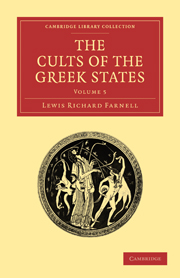Book contents
- Frontmatter
- PREFACE
- Contents
- LIST OF PLATES IN VOL. V
- CHAPTER I CULTS OF HERMES
- CHAPTER II CULT-MONUMENTS OF HERMES
- CHAPTER III THE IDEAL OF HERMES
- CHAPTER IV CULTS OF DIONYSOS
- CHAPTER V DIONYSIAC RITUAL
- CHAPTER VI CULT-MONUMENTS OF DIONYSOS
- CHAPTER VII IDEAL DIONYSIAC TYPES
- CHAPTER VIII CULTS OF HESTIA
- CHAPTER IX CULTS OF HEPHAISTOS
- CHAPTER X CULTS OF ARES
- CHAPTER XI MINOR CULTS
- INDEX
- Plate section
CHAPTER III - THE IDEAL OF HERMES
Published online by Cambridge University Press: 03 May 2011
- Frontmatter
- PREFACE
- Contents
- LIST OF PLATES IN VOL. V
- CHAPTER I CULTS OF HERMES
- CHAPTER II CULT-MONUMENTS OF HERMES
- CHAPTER III THE IDEAL OF HERMES
- CHAPTER IV CULTS OF DIONYSOS
- CHAPTER V DIONYSIAC RITUAL
- CHAPTER VI CULT-MONUMENTS OF DIONYSOS
- CHAPTER VII IDEAL DIONYSIAC TYPES
- CHAPTER VIII CULTS OF HESTIA
- CHAPTER IX CULTS OF HEPHAISTOS
- CHAPTER X CULTS OF ARES
- CHAPTER XI MINOR CULTS
- INDEX
- Plate section
Summary
As this god was so popular a figure of Greek polytheism and art, we are able to answer without difficulty the question before us now, under what forms was Hermes conceived by the Hellenic imagination from the first period onward? For the series of monuments is practically unbroken, from the uncouth aniconic or phallic emblem onwards and upwards, to the masterpiece of Greek sculpture that the fortune of our times has revealed to us.
We may suppose that the Homeric world may have sometimes imagined him as a young and beautiful god: at least, when he walks among men, he is said to be ‘like to a youth, before the hair has grown on his cheek, whose young prime is then most lovely.’ But it was not till long after Homer that the artists came to represent him thus.
Among the earliest iconic types may be quoted a very archaic bronze from Perugia of Hermes carrying the kerykeion, and wearing a peaked cap (P1. IX). With this we may compare one of the earliest monuments of Arcadia, a bronze statuette from Andritzena, in the Central Museum of Athens, a work of the sixth century, mentioned above as one of the earliest representations of Hermes the Ram-bearer (P1. X). The forms are powerful, though stunted, and present the sturdy type of the shepherd-athlete, combined, perhaps intentionally, with a hint in the countenance of the genial malice characteristic of the god.
- Type
- Chapter
- Information
- The Cults of the Greek States , pp. 44 - 84Publisher: Cambridge University PressPrint publication year: 2010First published in: 1909



